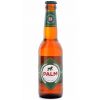Brouwerij Palm - Palm Spéciale Belge
-
ABV:
5.2% -
Bottle Size:
330-ml -
Int’l Bittering Units (IBUs):
18 -
Suggested Glassware:
Tulip, Snifter, Goblet
A century ago, during a time in which pilsner-style lagers were sweeping Europe and the world, the Belgian Brewers Guild challenged its members to create a traditionally-made but lower-gravity Belgian ale to compete. Palm’s answer to the guild and the trend towards easy-drinking beers was their Spéciale Belge (often branded today simply as Palm, as it’s the brewery’s flagship beer), a sessionable ale with a very pilsner-like 5.2% ABV and 18 IBUs. Golden-amber on the pour with perfect clarity, it offers up prominent malty notes tending toward caramel and nutty bread. Palm uses Kent Golding hops from England – a hop that is a major player in the aroma and overall character of ales from that country. Not surprisingly, there’s a very English-like gentle floral quality with an herbal touch that’s almost tea-like, with a wisp of lemon. We felt the English character carried into the flavor as well; look for the malt to deliver a biscuity-bready note amid caramel tones while the hops nicely balance the mild honeyed residual sweetness. We picked up a mild stone fruit character too, contributed by the three secret yeast strains that Palm uses to ferment this brew. Try pairing with fish & chips, roasted chicken, or a snack of Edam cheese. Cheers!
Documentary evidence of a farmstead in Steenhuffel, Belgium called De Hoorn (the horn) has been found dating back to at least 1597, and there’s evidence of a farmhouse brewery on the property by 1686. But it’s 1747 that appears on Palm’s labels because it was in that year that a census shows commercial brewing at the De Hoorn brewery (known today as Palm), owned by a Jean-Baptiste De Mesmaecker. In 1908 a direct descendant, Henriette De Mesmaecker, married brewer Arthur Van Roy and brewing operations at De Hoorn flourished. Despite the growing popularity of pilsner beer at that time, Arthur was dedicated to the Belgian ale tradition and refused to embrace the ease of following the modern trend. Sadly, Brouwerij De Hoorn was destroyed in WWI, but Van Roy rebuilt it – bigger and better.
In the late ‘20s, Arthur’s son Alfred learned to brew from his father and studied brewing at brewing school in Brussels. In 1929, Alfred renamed their most popular beer “Spéciale Palm,” a reference to a palm leaf crown as a symbol of a victory of top-fermented ale over the still growing bottom-fermenting lager segment. When Arthur died in 1952, Alfred assumed control, and over succeeding decades instituted a variety of upgrades including two new brewhouses boasting traditional copper kettles.
After Alfred’s first wife passed away, he married Aline Verleyen in 1968. Like Alfred’s first wife, Aline was also from a brewing family and in 1974 her nephew Jan Toye took over brewery management. Known primarily as the brewers of Palm branded beer, De Hoorn officially changed its name to Palm a year later. Since that time, Palm has been very active in the Belgian beer world. They acquired Brouwerij De Gouden Boom and the license to brew the Steenbrugge abbey beers, as well as the landmark sour ale brewery, Rodenbach, in which they invested much capital on massive renovations to the whole brewery premises surrounding Rodenbach’s hundreds of huge oak foudre aging vessels. Palm also entered into a joint venture with Brouwerij Boon in 1990 to make high quality Gueuze. To this day, Jan remains at the helm of Brouwerij Palm. Alfred Van Roy remained active in the business for 75 years until passing away at age 96 in 2009.

Unmatched Variety by style, brewery & country
Choose from Five different Beer Clubs offering unmatched variety by brewery,
country of origin, and beer style to suit your specific tastes.


